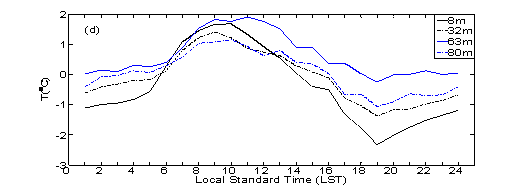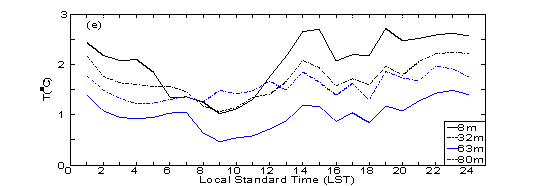The impacts of this urbanization process on both the vertical profile and diurnal cycles of air temperature are investigated using hourly data collected from a series of monitoring levels (up to 325 m high) on the Beijing meteorological tower since 1984. We find that the inter-decadal temperature has increased gradually, and that a more significant increase occurred during the 1980s and 1990s due to the effects of urbanization. A well-defined change in temperature stratification was also observed over this period. The height of the temperature inversion layer decreased from the 1980s to the 2000s. A well-defined nighttime temperature inversion developed below 50 m during the summer in the 1980s, but this near-surface inversion is not seen in data from the 1990s and 2000s. This change can be related to an increase in turbulent mixing caused by urban roughness and surface heat storage that disturbs the near surface temperature inversion layer. In addition, the diurnal change in temperature in the city in summer shows a maximum increase from sunrise to the early afternoon, which is mainly caused by the nature variability and global warming in both the summer and winter. The urbanization mainly contributes to the temperature increase in the afternoon and nighttime. Moreover the urbanization dominates the increase in daily mean near-surface temperature. The study has been published in Climatic Change, the lead author is Ph.D student Yu Miao at LASG, and coauthors are Dr. Liu Yimin at LASG, Ph. D student Dai Yifeng at LASG, Dr. Yang Aqiang at Institute of Remote Sensing Applications, Chinese Academy of Sciences.





Figure: Diurnal temperature variation during summer at (a) Beijing in the 1980s, (b) Beijing in 2000s, and (c) Beijing in the 2009 minus Beijing in the 1980s - total change, (d) Xianghe in 2009 minus Beijing in the 1980s –impact from large scale variation, and (e) Beijing in 2009 minus Xianghe in 2009 – urban impact.
More information at:
http://link.springer.com/article/10.1007%2Fs10584-013-0788-2/fulltext.html
